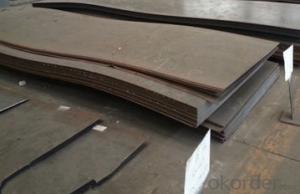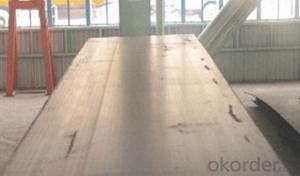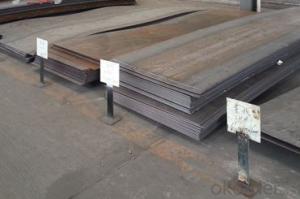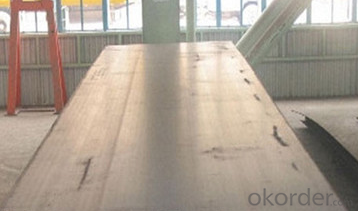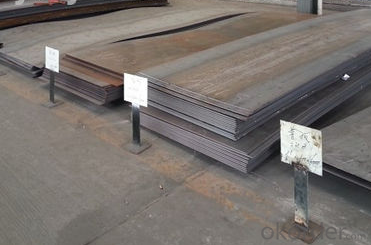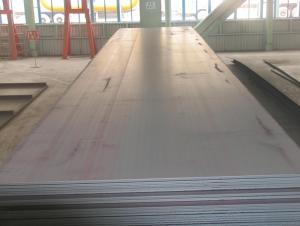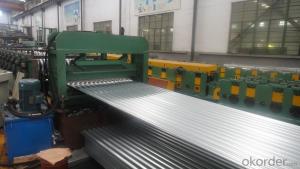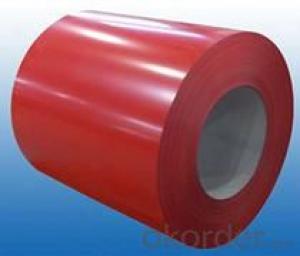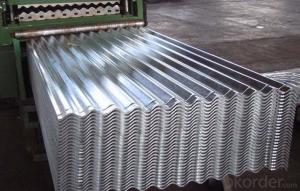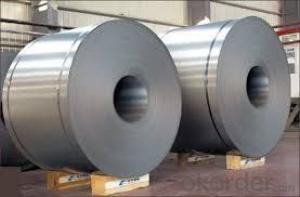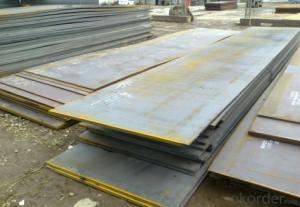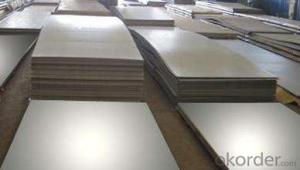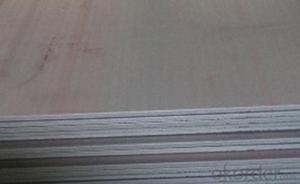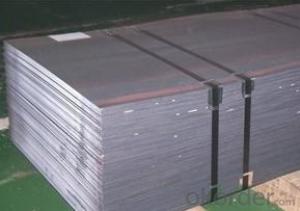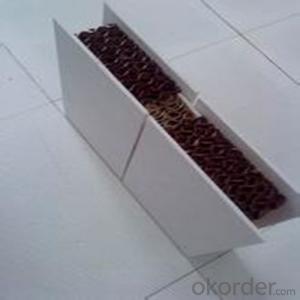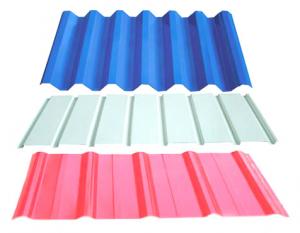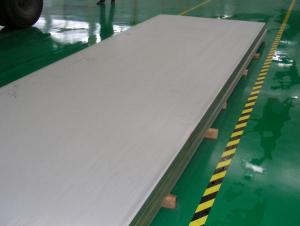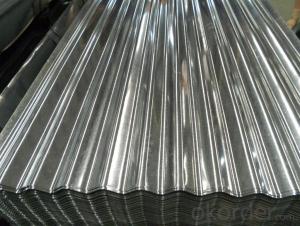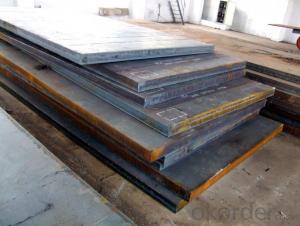Hot Rolled Carbon Steel Sheet A573 CNBM
- Loading Port:
- Qingdao
- Payment Terms:
- TT OR LC
- Min Order Qty:
- 10 pc
- Supply Capability:
- 30 pc/month
OKorder Service Pledge
Quality Product, Order Online Tracking, Timely Delivery
OKorder Financial Service
Credit Rating, Credit Services, Credit Purchasing
You Might Also Like
Quick Details
| Standard: | AISI, ASTM, DIN, GB, JIS | Grade: | A572,A573,A633,A678,A709,A710,G3101,G3136,etc | Thickness: | 1mm-200mm |
| Brand Name: | SHOU GANG GROUP, AN STEEL | Model Number: | Q235 | ||
| Type: | Steel Plate | Technique: | Hot Rolled | Surface Treatment: | Coated |
| Application: | widely | Special Use: | High-strength Steel Plate | Width: | 1000mm-3000mm |
| Length: | 1000mm-12000mm | Price Term: | FOB CIF CFR |
Packaging & Delivery
| Packaging Details: | standard seaworthy export packing or as the request of customers |
| Delivery Detail: | 10 days after deposit or according to customers' quantity |
Specifications
hot rolled carbon steel sheet
1.Thickness:1mm-200mm
2.Length:1000mm-12000mm
3.Width:1000mm-2000mm
hot rolled carbon steel sheet
| Product | HR steel plate prices carbon steel plate prices per kg |
| MOQ | 25 ton |
| Thickness | 1mm-200mm |
| Width | 1000mm-3000mm |
| Length | 1000mm-12000mm |
| Application | widely |
| Standard | AISI,ASTM,BS,DIN,JIS,GB,etc |
| Grade | A572,A573,A633,A678,A709,A710,G3101,G3136,etc |
| Tpye | Steel plate |
| Surfacing | Coated |
| Productive Technology | Hot Rolled & Cold Rolled |
| Port | |
| Payment Terms | L/C,T/T,Western Union,MoneyGram |
| Product Ability | 5000 tons per month |
| Delivery | 10 days after deposit or according to customers' quantity |
| Packing | standard seaworthy export packing or as the request of customers |
- Q: Can steel sheets be used for cladding?
- Yes, steel sheets can be used for cladding.
- Q: What are the common surface treatments for steel sheets?
- The common surface treatments for steel sheets include galvanizing, powder coating, painting, and plating.
- Q: What is the average weight of a steel sheet?
- The average weight of a steel sheet can vary depending on its dimensions and thickness.
- Q: What is the standard size of a steel sheet?
- The specific application and industry play a significant role in determining the varying standard sizes of steel sheets. However, it is common to find steel sheets in standard sizes like 4 feet by 8 feet (1.2 meters by 2.4 meters) or 5 feet by 10 feet (1.5 meters by 3 meters). These dimensions are widely utilized in construction, manufacturing, and fabrication processes. It is worth mentioning that customized sizes can be obtained to cater to the specific needs of a project or customer.
- Q: What are the main applications of steel sheets?
- Due to their durability, strength, and versatility, steel sheets have a wide range of applications in various industries. Some of the main uses of steel sheets include: 1. Construction: The construction industry extensively utilizes steel sheets for constructing beams, columns, and structural frames. These sheets provide strength and stability to buildings, bridges, and other infrastructure projects. 2. Automotive industry: In the automotive industry, steel sheets are widely used for manufacturing vehicle bodies, chassis, and other structural components. This is because they offer high strength and impact resistance, ensuring passenger safety. 3. Manufacturing and machinery: Steel sheets are employed in the manufacturing sector for fabricating heavy machinery, equipment, and industrial tools. Their high tensile strength and resistance to wear and tear make them suitable for demanding applications. 4. Appliances and electronics: Household appliances such as refrigerators, washing machines, and ovens commonly incorporate steel sheets. These sheets provide a sturdy and durable outer casing, protecting the internal components. 5. Energy and power generation: In the power generation industry, steel sheets are essential for constructing power plants, transmission towers, and wind turbines. They can withstand extreme weather conditions and provide structural integrity. 6. Packaging industry: Steel sheets are utilized in the manufacturing of packaging materials like cans, drums, and containers. They ensure the safety and preservation of goods during transportation and storage. 7. Aerospace and defense: The aerospace and defense sectors rely on steel sheets for manufacturing aircraft parts, missiles, and armored vehicles. This is due to their high strength-to-weight ratio, which is crucial for these industries. 8. Furniture and interior design: Steel sheets are incorporated in the production of furniture, fixtures, and decorative elements. They offer a modern and sleek appearance while providing durability and stability. In conclusion, steel sheets are highly versatile and find applications in numerous industries, thanks to their strength, durability, and diverse range of properties.
- Q: Can steel sheets be used for electrical grounding purposes?
- Certainly! Electrical grounding purposes can indeed utilize steel sheets. Steel, being an excellent conductor of electricity, is well-suited for grounding applications. By appropriately linking them to an electrical system, steel sheets can offer an efficient route for the discharge of electrical charges and the avoidance of electrical shock risks. Nevertheless, it is crucial to guarantee that the steel sheets are suitably bonded and connected to the grounding system to establish a path of low resistance for fault currents. Furthermore, factors like the thickness and surface area of the steel sheets should be taken into account to ensure they satisfy the criteria for effective grounding.
- Q: What is the difference between a brushed and polished steel sheet?
- A brushed steel sheet and a polished steel sheet differ in terms of their surface finishes. A brushed steel sheet is characterized by a pattern of parallel lines or scratches on its surface, created using abrasive materials or tools. The purpose of brushing is to give the steel sheet a textured appearance, which helps to hide fingerprints, scratches, and wear over time. It also provides a more industrial, matte finish. On the other hand, a polished steel sheet has a smooth and glossy surface. Polishing involves using polishing compounds or abrasive materials to remove imperfections, scratches, and oxidation from the steel surface. This process creates a reflective and mirror-like finish, enhancing the aesthetic appeal of the steel sheet. Polished steel sheets are commonly used in applications where appearance and visual appeal are important, such as architectural design, interior decoration, and high-end products. In summary, the main difference between a brushed and polished steel sheet lies in their surface finishes. Brushed steel sheets have a textured, matte appearance, while polished steel sheets have a smooth and glossy, mirror-like finish. The choice between the two depends on the desired aesthetic, functional requirements, and the intended application of the steel sheet.
- Q: What is the difference between a galvanized and aluminized steel sheet?
- Galvanized steel and aluminized steel sheets are both widely used in various industries due to their durability and corrosion-resistant properties. However, there are distinct differences between the two. Galvanized steel sheets are coated with a layer of zinc to protect the underlying steel from rust and corrosion. This process, known as galvanization, involves immersing the steel sheet in a bath of molten zinc or applying a zinc-rich coating through electroplating. The zinc layer acts as a sacrificial barrier, meaning that it will corrode before the steel does, providing excellent protection against rust. Galvanized steel is commonly used in outdoor applications, such as roofing, fences, and automobile parts. On the other hand, aluminized steel sheets are coated with a layer of aluminum-silicon alloy. This process, known as aluminization, involves hot-dipping the steel sheet in a bath of molten aluminum or applying a thin layer of aluminum-silicon alloy through a continuous hot-dip process. The aluminum-silicon coating offers excellent heat resistance and corrosion resistance. Aluminized steel is commonly used in applications where high temperatures are present, such as automotive exhaust systems, heat exchangers, and ovens. In summary, the main difference between galvanized and aluminized steel sheets lies in the type of coating applied to the steel. Galvanized steel is coated with zinc, providing excellent rust protection, while aluminized steel is coated with an aluminum-silicon alloy, providing superior heat and corrosion resistance. The choice between the two depends on the specific requirements of the application, such as the presence of high temperatures or the need for long-lasting rust protection.
- Q: What are the different hardness levels available for steel sheets?
- The different hardness levels available for steel sheets range from soft to very hard, with common options being mild steel, hot-rolled steel, cold-rolled steel, and stainless steel. These hardness levels determine the steel's ability to resist deformation and wear, making it suitable for various applications based on the required strength and durability.
- Q: Can steel sheets be used for structural beams?
- No, steel sheets cannot be used for structural beams. Structural beams require a specific shape and design to support heavy loads and distribute weight effectively, which cannot be achieved with flat steel sheets.
Send your message to us
Hot Rolled Carbon Steel Sheet A573 CNBM
- Loading Port:
- Qingdao
- Payment Terms:
- TT OR LC
- Min Order Qty:
- 10 pc
- Supply Capability:
- 30 pc/month
OKorder Service Pledge
Quality Product, Order Online Tracking, Timely Delivery
OKorder Financial Service
Credit Rating, Credit Services, Credit Purchasing
Similar products
Hot products
Hot Searches
Related keywords
